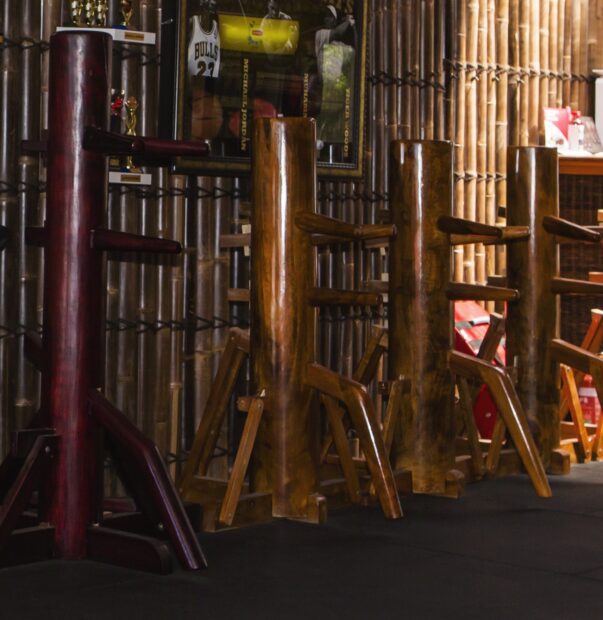Wing Chun Dummies Their Utility: Enhancing Training When Partners Are Unavailable
By Maurice Novoa a master under the Yuen Kay Shan, Ip Man and Pan Nam lineages.
Introduction: Exploring the Value of Wing Chun Dummies
Wing Chun, a highly practical martial art known for its close-quarters combat techniques, emphasizes the importance of effective training methods. One such training tool is the Wing Chun dummy, or Muk Yan Jong. In this article, we will delve into the usefulness of Wing Chun dummies, particularly in situations where a training partner is not readily available. It is important to note that while dummies can enhance training, they are not a prerequisite for mastering Wing Chun.
Understanding the Purpose of Wing Chun Dummies
Wing Chun dummies are wooden structures designed to simulate a training partner, enabling practitioners to practice techniques, footwork, and timing in the absence of a live partner. The dummy consists of arms, a central wooden body, and legs, providing a stable structure for training. While the dummy is traditionally associated with Wing Chun, it is not exclusive to the art and can be utilized by practitioners of various martial arts.
The Unique Effectiveness of Wing Chun Dummies: A Step Beyond Karate Kata
Wooden dummies have gained recognition not only within the realm of Wing Chun but also among practitioners of other martial arts, including Karate. While Karate practitioners are familiar with the concept of Kata, Wing Chun dummies offer a distinct and highly effective training experience that sets them apart.
Kata, a series of prearranged movements practiced in Karate, serves as a training tool to develop technique, focus, and form. Similarly, wooden dummies provide a structured training platform. However, the effectiveness of Wing Chun dummies lies in their dynamic and adaptable nature, offering practitioners a unique training experience.
Wooden dummies go beyond the static nature of Karate Kata. The dummy’s arms and structure provide tangible targets for strikes, blocks, and traps, allowing practitioners to train their techniques with full force and accuracy. This hands-on approach helps refine movements and develop muscle memory more effectively compared to the theoretical execution of Kata.
Furthermore, Wing Chun dummies foster a deeper understanding of close-quarters combat and the practical application of techniques. Wing Chun, renowned for its efficiency and effectiveness in real-world situations, places great emphasis on adaptability and responsiveness. The dummy’s presence allows practitioners to simulate various scenarios, adjusting their techniques, footwork, and timing accordingly. This level of dynamic interaction cannot be fully replicated in the static movements of traditional Kata.
The versatility of wooden dummies is another aspect that sets them apart from Karate Kata. While Kata serves as a predetermined sequence of movements, Wing Chun dummies offer practitioners the freedom to explore and experiment with different techniques, angles, and ranges. This adaptability is crucial in developing the ability to react and respond to an opponent’s actions fluidly. Practitioners can practice a wide range of strikes, kicks, and trapping techniques, adjusting their movements in real-time to create a more realistic training environment.
Moreover, Wing Chun dummies enable practitioners to train with full force without the risk of injuring a training partner. This freedom to apply power and intensity in training builds confidence in one’s abilities and mental resilience, essential attributes in real-life self-defense situations. The combination of power, precision, and adaptability makes Wing Chun dummies an invaluable tool for practitioners seeking a more practical and realistic training experience.
While Karate Kata serves as a foundational training method in Karate, Wing Chun dummies take training to the next level. The unique characteristics of Wing Chun dummies, such as their dynamic nature, practicality, and adaptability, provide practitioners with a more effective means of honing their skills. The hands-on experience, coupled with the ability to apply full force and simulate real-life combat scenarios, sets Wing Chun dummies apart as an exceptional training tool.
The dummies offer a distinct and highly effective training experience that goes beyond the static nature of Karate Kata. Their dynamic and adaptable nature allows practitioners to develop their techniques, footwork, and timing in a more practical and realistic manner. By providing tangible targets and promoting adaptability, Wing Chun dummies offer a level of effectiveness that sets them apart as an invaluable tool for martial artists seeking to enhance their training and real-world combat abilities.
Training Without a Partner: Filling the Gap with Dummies
In Wing Chun, the importance of training with a partner cannot be overstated. However, circumstances may arise when a training partner is unavailable. This is where the Wing Chun dummy proves its worth. It serves as a valuable training aid, allowing practitioners to continue their training and development even without a live partner. The dummy’s arms and structure provide targets for strikes, enabling practitioners to refine techniques, enhance accuracy, and develop power.
Enhancing Technique and Timing: The Benefits of Dummy Training
Training with a wooden dummy offers several benefits. Firstly, it allows practitioners to refine their techniques by repeatedly practicing strikes, blocks, and traps. The dummy’s immobile nature allows for focused repetition, helping to develop muscle memory and precision. Secondly, working with the dummy enhances timing and coordination as practitioners learn to flow seamlessly from one technique to another. This timing aspect is crucial in close-quarters combat situations where split-second reactions can make all the difference.
Adaptability and Practicality: The Value of Dummy Training
Wing Chun dummies promote adaptability and practicality in training. By practicing with the dummy, practitioners learn to adapt their techniques and footwork to different angles, heights, and positions. This adaptability becomes particularly valuable in real-life self-defense scenarios where opponents may vary in size, strength, and fighting style. Moreover, the dummy enables practitioners to practice techniques at full force without the risk of injuring a training partner, instilling confidence in their abilities and building mental resilience.
Supplementing Live Partner Training: A Comprehensive Approach
While Wooden dummies offer numerous advantages, they should not replace training with live partners. Training with a partner provides the opportunity for realistic interaction, allowing practitioners to develop sensitivity, timing, and adaptability in a dynamic setting. It is essential to strike a balance between dummy training and live partner training to ensure a well-rounded and comprehensive skill set in Wing Chun.
Conclusion: The Versatility of Wooden Dummies
In conclusion, Wooden dummies serve as valuable training tools in situations where a live partner is unavailable. They provide opportunities for refining techniques, enhancing accuracy, and developing power, all while promoting adaptability and practicality. However, it is crucial to remember that while dummies can enhance training, they are not a prerequisite for mastering Wing Chun. Balancing dummy training with live partner training ensures a holistic and comprehensive approach to mastering the art.

